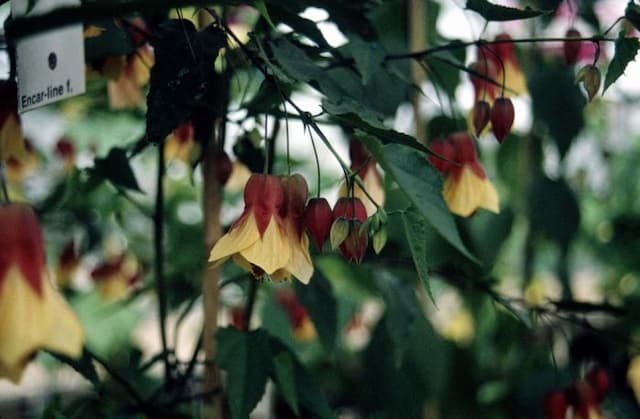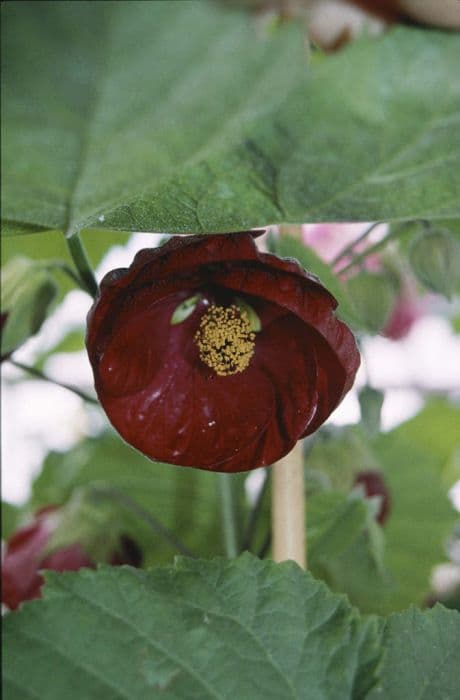Prairie Mallow Sidalcea 'Oberon'

ABOUT
Sidalcea 'Oberon', often known as the checkerbloom or mini hollyhock, is an ornamental garden plant with endearing floral and foliage characteristics. The plant typically displays a bushy clump of lobed leaves that are green in color, with a texture that can range from soft to slightly furry. As it matures, the foliage provides a dense and attractive backdrop for the flowers. The blooms are the most striking feature of the Sidalcea 'Oberon', presenting a lively display of color. They resemble miniature hollyhocks, with individual flowers arranged on erect, slender spikes that grow above the foliage. Each delicate flower has a cup or saucer shape, often with five rounded petals that create a charming, open-faced look. The petals display varying shades, frequently in the pink to purple spectrum, sometimes with deeper colored veins running through them. Adding to the appeal of the checkerbloom are the flower centers, which typically exhibit a contrasting color, often in the form of a prominent central stamen cluster. This contrast can attract pollinators and adds to the plant's ornamental value. The blooming period extends throughout the summer months, offering a long season of visual interest. When in bloom, the checkerbloom can have a somewhat airy and whimsical appearance, as the flowers dance atop the stalks with a gentle sway in the breeze. Overall, Sidalcea 'Oberon' has a rounded and soft appearance in the landscape, favored for its traditional cottage garden feel and ability to add a splash of color and vertical interest without reference to its dimensions.
About this plant
 Names
NamesFamily
Malvaceae.
Synonyms
Checkerbloom, Miniature Hollyhock, Dwarf Prairie Mallow, Oberon Checkerbloom.
Common names
Sidalcea 'Oberon'.
 Toxicity
ToxicityTo humans
Checker mallow is generally not known for its toxicity to humans. There are no widely recognized toxic effects from ingesting this plant. However, as with any plant that is not commonly consumed, individuals may experience varying sensitivities or allergic reactions. If such symptoms occur, seek medical advice. It is always prudent to avoid ingesting parts of ornamental plants unless they are known to be edible.
To pets
Checker mallow is not known to be toxic to pets. There are no significant reports that suggest toxicity for dogs, cats, or other pets if they ingest parts of this plant. However, it’s always best to monitor your pets and prevent them from eating non-food plants, as individual animals might have unique sensitivities or allergic reactions. In case of any unusual symptoms after ingestion, consult with a veterinarian.
 Characteristics
CharacteristicsLife cycle
Perennials
Foliage type
Deciduous
Color of leaves
Green
Flower color
Pink
Height
2 feet (0.61 meters)
Spread
1 foot (0.3 meters)
Plant type
Herb
Hardiness zones
5
Native area
North America
Benefits
 General Benefits
General Benefits- Attracts pollinators - Sidalcea 'Oberon', commonly known as Checker Mallow, is attractive to bees, butterflies, and other beneficial insects, encouraging a healthy and diverse garden ecosystem.
- Low maintenance - This plant is known for being easy to care for and requiring minimal upkeep, which is ideal for gardeners of all levels.
- Drought tolerance - Once established, it has good drought resistance, making it suitable for xeriscaping and reducing the need for frequent watering.
- Long blooming period - Checker Mallow has a lengthy blooming time from midsummer to early fall, providing extended color and interest in the garden.
- Cold hardiness - It is capable of withstanding cooler temperatures, making it suitable for a variety of climates.
- Landscape versatility - Checker Mallow can be used in borders, wildflower meadows, cottage gardens, and as a cut flower, offering multiple uses in the landscape.
- Deer resistance - The plant is generally not preferred by deer, reducing the likelihood of damage in areas where deer are prevalent.
 Medical Properties
Medical PropertiesThis plant is not used for medical purposes.
 Air-purifying Qualities
Air-purifying QualitiesThis plant is not specifically known for air purifying qualities.
 Other Uses
Other Uses- Sidalcea 'Oberon', commonly known as Checker mallow, can be used in natural dye production; its flowers and leaves may yield subtle colors when used in traditional dyeing processes.
- The fibrous stems of Checker mallow can be woven into small baskets or decorative items by skilled craftspeople who specialize in using natural plant materials.
- The Checker mallow's dense foliage provides a natural habitat and shelter for beneficial insects and small wildlife in the garden.
- Checker mallow can act as a natural erosion control specimen in landscapes prone to soil degradation due to its spreading habit and root structure.
- The dry stalks of Checker mallow post-bloom are sometimes used in rustic floral arrangements for their unique texture and architectural interest.
- Children can use the hollow stems of Checker mallow for creating natural straws or blowpipes for small, lightweight seeds in outdoor play.
- Checker mallow's blossoms can serve as an indicator plant for phenology studies, as their blooming period marks specific seasonal changes in many regions.
- Pressed flowers from the Checker mallow can be used in craft projects such as making bookmarks, handmade paper, or botanical prints.
- Checker mallow seeds can be included as a part of a "grow your own" gift set aimed at amateur gardeners or educational kits for schools.
- Used in companion planting, Checker mallow can support the growth of vegetables by attracting pollinators and thus increasing the yield of crops like squash and tomatoes.
Interesting Facts
 Feng Shui
Feng ShuiThe Checker Mallow is not used in Feng Shui practice.
 Zodiac Sign Compitability
Zodiac Sign CompitabilityThe Checker Mallow is not used in astrology practice.
 Plant Symbolism
Plant Symbolism- Daintiness: Sidalcea 'Oberon', commonly known as the miniature hollyhock, often symbolizes daintiness due to its delicate, fine petals and intricate structure, representing grace and gentle beauty.
- Femininity: The soft blossoms reminiscent of classic hollyhocks are associated with traditional feminine qualities such as gentleness, care, and nurturing.
- Versatility: As miniature hollyhocks can adapt to various garden roles, they symbolize versatility and the ability to thrive in diverse environments or situations.
- Bounty: Since the plant produces a generous amount of flowers during its bloom time, it's often linked to ideas of abundance and generosity.
- Longevity: Miniature hollyhock is a perennial plant, returning each year, which symbolizes persistence, endurance, and the notion of long-lasting life or relationships.
- Amiability: The plant's friendly and non-demanding nature makes it a symbol of amiability, congeniality, and the simple joys of friendship.
 Water
WaterCheckerbloom should be watered thoroughly whenever the top inch of soil feels dry to the touch. Ensuring the plant receives 1 to 1.5 inches of water weekly is ideal for maintaining consistent soil moisture. Water at the base of the plant to avoid wetting the foliage, as this can lead to fungal diseases. Use a watering can or hose to gently soak the soil without causing erosion. During hot, dry periods, additional watering may be necessary, but always avoid overwatering to prevent root rot.
 Light
LightCheckerbloom thrives in full sun to partial shade, preferring at least 6 hours of direct sunlight each day. The best spot for this plant is one that receives morning sunlight and partial shade in the afternoon, which helps protect it during the hottest part of the day. An east-facing garden bed is typically ideal for meeting these light requirements.
 Temperature
TemperatureCheckerbloom prefers temperatures between 60°F and 80°F for optimal growth. It can survive minimum temperatures down to about 20°F, making it suitable for USDA hardiness zones 5 through 9. Avoid exposing the plant to temperatures above 90°F, as extreme heat can cause stress and damage.
 Pruning
PruningPrune Checkerbloom to promote vigorous growth and to maintain a neat appearance. Deadheading spent blooms can encourage a second flowering in late summer. Cut back the plant in late fall or early spring to help rejuvenate the plant and remove any dead or damaged stems. Pruning is typically done annually or as needed to control the shape and size of the plant.
 Cleaning
CleaningAs needed
 Soil
SoilThe Checkerbloom prefers well-draining soil with a mix of loam, peat, and sand. The ideal soil pH for Sidalcea 'Oberon' is between 5.8 and 6.8. A balanced mix will ensure proper drainage and aeration for healthy root growth.
 Repotting
RepottingCheckerblooms like Sidalcea 'Oberon' generally do not require frequent repotting; every 2-3 years is sufficient. It is best repotted when the plant shows signs of becoming root-bound or when soil quality degrades.
 Humidity & Misting
Humidity & MistingCheckerblooms such as Sidalcea 'Oberon' prefer moderate humidity conditions. The best humidity level for this perennial is around 40-60%, similar to the ambient outdoor humidity in its natural growing areas.
 Suitable locations
Suitable locationsIndoor
Place in well-lit area, ensuring moist but well-draining soil.
Outdoor
Full sun to partial shade, protect from harsh winds, mulch soil.
Hardiness zone
5-9 USDA
 Life cycle
Life cycleCheckerbloom 'Oberon' is a herbaceous perennial plant, meaning its life cycle spans more than two years, often with phases of active growth and dormancy. Initially, it begins as a seed, which upon finding suitable soil and moisture conditions, germinates to produce a small seedling. As it grows, it develops into a rosette of leaves at the soil surface during its first year, relying on energy stored in the leaves and roots to survive winter dormancy. Upon entering its second year, 'Oberon' undergoes a period of rapid vegetative growth, producing taller stems, more leaves, and finally flowering stalks that bear its distinctive pink flowers in late spring to summer. After pollination, typically by bees or butterflies, the plant sets seed before the aerial parts die back, leaving the root system to survive underground. Each subsequent year, Checkerbloom 'Oberon' follows a similar cycle of regrowth, flowering, seed setting, and senescence, with each cycle contributing to the spread and perpetuation of the species.
 Propogation
PropogationPropogation time
Spring to early summer
Propogation: Sidalcea 'Oberon', commonly known as checker mallow or prairie mallow, can be propagated through division, a process which is best done in early spring or fall. To propagate by division, carefully dig up a well-established plant, preferably one that's at least a few years old, and gently separate the clump into smaller sections, ensuring that each new section has a portion of the roots and a few shoots. These divisions can then be replanted in well-prepared soil, spaced approximately 12 to 18 inches (30 to 45 centimeters) apart, to allow sufficient space for growth. Water the new plantings thoroughly to help establish the root system. This method of propagation is popular for its simplicity and effectiveness in creating new plants that are true to the species.









